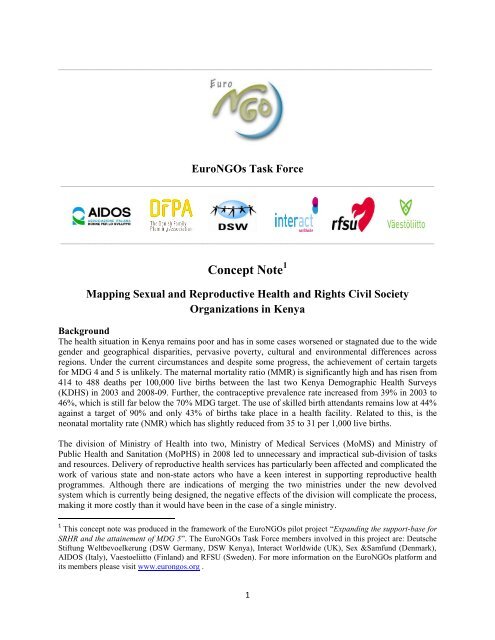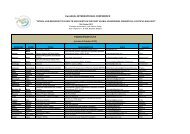Concept Note - EuroNGOs
Concept Note - EuroNGOs
Concept Note - EuroNGOs
You also want an ePaper? Increase the reach of your titles
YUMPU automatically turns print PDFs into web optimized ePapers that Google loves.
__________________________________________________________________<br />
<strong>EuroNGOs</strong> Task Force<br />
__________________________________________________________________<br />
__________________________________________________________________<br />
<strong>Concept</strong> <strong>Note</strong> 1<br />
Mapping Sexual and Reproductive Health and Rights Civil Society<br />
Organizations in Kenya<br />
Background<br />
The health situation in Kenya remains poor and has in some cases worsened or stagnated due to the wide<br />
gender and geographical disparities, pervasive poverty, cultural and environmental differences across<br />
regions. Under the current circumstances and despite some progress, the achievement of certain targets<br />
for MDG 4 and 5 is unlikely. The maternal mortality ratio (MMR) is significantly high and has risen from<br />
414 to 488 deaths per 100,000 live births between the last two Kenya Demographic Health Surveys<br />
(KDHS) in 2003 and 2008-09. Further, the contraceptive prevalence rate increased from 39% in 2003 to<br />
46%, which is still far below the 70% MDG target. The use of skilled birth attendants remains low at 44%<br />
against a target of 90% and only 43% of births take place in a health facility. Related to this, is the<br />
neonatal mortality rate (NMR) which has slightly reduced from 35 to 31 per 1,000 live births.<br />
The division of Ministry of Health into two, Ministry of Medical Services (MoMS) and Ministry of<br />
Public Health and Sanitation (MoPHS) in 2008 led to unnecessary and impractical sub-division of tasks<br />
and resources. Delivery of reproductive health services has particularly been affected and complicated the<br />
work of various state and non-state actors who have a keen interest in supporting reproductive health<br />
programmes. Although there are indications of merging the two ministries under the new devolved<br />
system which is currently being designed, the negative effects of the division will complicate the process,<br />
making it more costly than it would have been in the case of a single ministry.<br />
1 This concept note was produced in the framework of the <strong>EuroNGOs</strong> pilot project “Expanding the support-base for<br />
SRHR and the attainement of MDG 5”. The <strong>EuroNGOs</strong> Task Force members involved in this project are: Deutsche<br />
Stiftung Weltbevoelkerung (DSW Germany, DSW Kenya), Interact Worldwide (UK), Sex &Samfund (Denmark),<br />
AIDOS (Italy), Vaestoeliitto (Finland) and RFSU (Sweden). For more information on the <strong>EuroNGOs</strong> platform and<br />
its members please visit www.eurongos.org .<br />
1
Objective of Mapping SRHR Civil Society Organizations in Kenya<br />
The purpose of mapping civil society organizations working in the reproductive health sub-sector is to<br />
provide stakeholders in the health sector including the Development Partners with an overview of<br />
main SRHR CSOs in Kenya. This exercise will provide a deeper understanding of their operations as<br />
well as their capacity to engage in reproductive health advocacy in an environment which is only partially<br />
supportive of SRHR. It will also help increase knowledge on the challenges that they face, in order to<br />
develop effective ways of supporting these organizations to undertake SRHR advocacy, monitor the<br />
progress of implementation of SRHR policies and build the capacity of communities to demand for<br />
adequate and quality SRHR services in health facilities. Additionally, it will enable the organizations to<br />
identify key allies with the potential to form strategic alliances for working towards improving the<br />
situation of SRHR in the country. It will also help them to understand the different initiatives that are<br />
taking place in diverse regions and how to build on them, in order to expand the interventions in the RH<br />
sub-sector without duplicating efforts in similar regions and targeting the same population.<br />
The activity is both timely and useful because it coincides with the efforts that are being made towards<br />
operationalizing the Constitution, 2010, development and implementation of multiple policies meant to<br />
improve the situation of SRHR in Kenya. As these efforts unfold, it is important to identify and<br />
consolidate the work of civil society organizations to contribute towards implementation of the new laws<br />
and policies. In addition, the Constitution is set to introduce a new set of structures and modify existing<br />
ones to ostensibly serve people in a more effective and transparent manner. The civil society remains a<br />
strategic actor in all these efforts and has a significant role, to complement the government’s work of<br />
strengthening the capacity of communities to take an active role in service delivery and monitoring the<br />
work of government’s institutions.<br />
Methodology, risks and assumptions and dissemination<br />
Given the time and resource limitations, the exercise will endevour to gather and analyze primary data<br />
from both urban and rural-based SRHR CSOs and networks using questionnaires and semi-structured<br />
interviews. Secondary data will be gathered from existing databases that are managed by the government<br />
and non-state actors. Some of the risks anticipated in this exercise are lack of access to relevant<br />
information and databases, lack of response (or low response rate) by the CSOs and misrepresentation of<br />
facts. The success of this exercise is therefore hinged on the assumption that information will easily be<br />
accessed and availed, the government and CSOs contacted will be responsive and they will provide<br />
accurate information.<br />
The data collected through questionnaires and semi-structured interviews will cover the following areas:<br />
name of the organization, duration of operation, target population, number of staff and annual turnover.<br />
Limited information regarding their programmes will also be gathered. This will be grouped into two,<br />
advocacy and other programmatic areas such as service delivery and training.<br />
The data collected will be analyzed and used to prepare a report describing the operations of SRHR civil<br />
society organizations, areas of focus and institutional capacities. The report will be widely disseminated<br />
among donors and if possible officially presented to the DPHK working group. In addition, it will be<br />
shared with CSOs within and outside the SRHR sub-sector as well as other key stakeholders including the<br />
Ministry of Health and other government institutions.<br />
2
Expected Results<br />
The activity serves an important purpose of documenting the number of SRHR civil society<br />
organizations in Kenya and the nature of their activities. This will help contribute to:<br />
‣ Increased knowledge on the number, work and capacity of SRHR CSOs in Kenya<br />
‣ Increased opportunity for networking and collaboration, sharing of knowledge and information<br />
among civil society organizations<br />
Report tentatively ready between July and August 2012<br />
Contacts:<br />
Ms. Margaret Wamuyu Muthee, Advocacy Officer, <strong>EuroNGOs</strong>/DSW, margaret.muthee@dswkenya.org<br />
Ms. Patrizia Pompili, Coordinator ad interim, <strong>EuroNGOs</strong> Secretairat, patrizia.pompili@eurongos.org<br />
Ms. Jacqueline Bryld, International Program Manager, DFPA, jb@sexogsamfund.dk<br />
3





